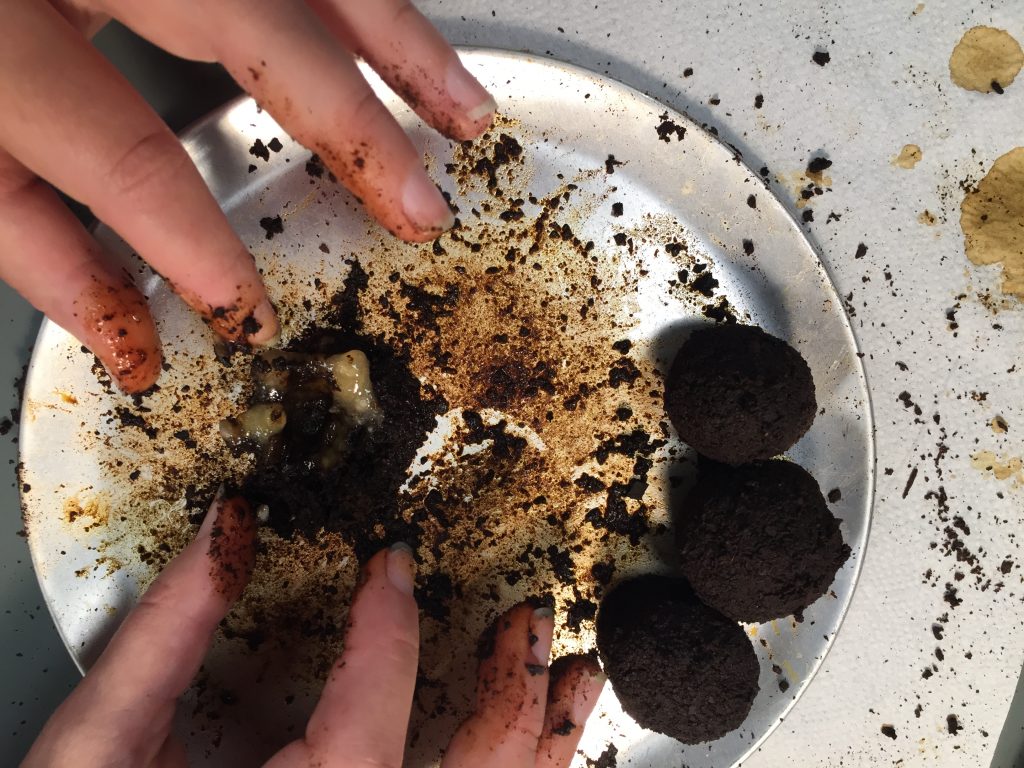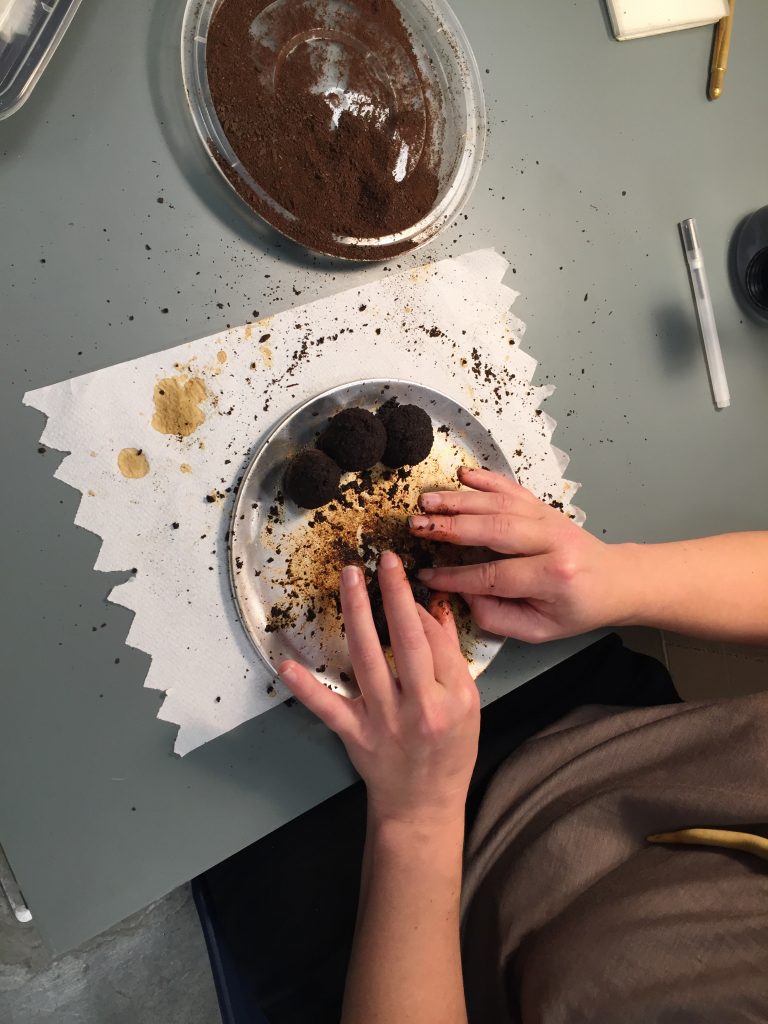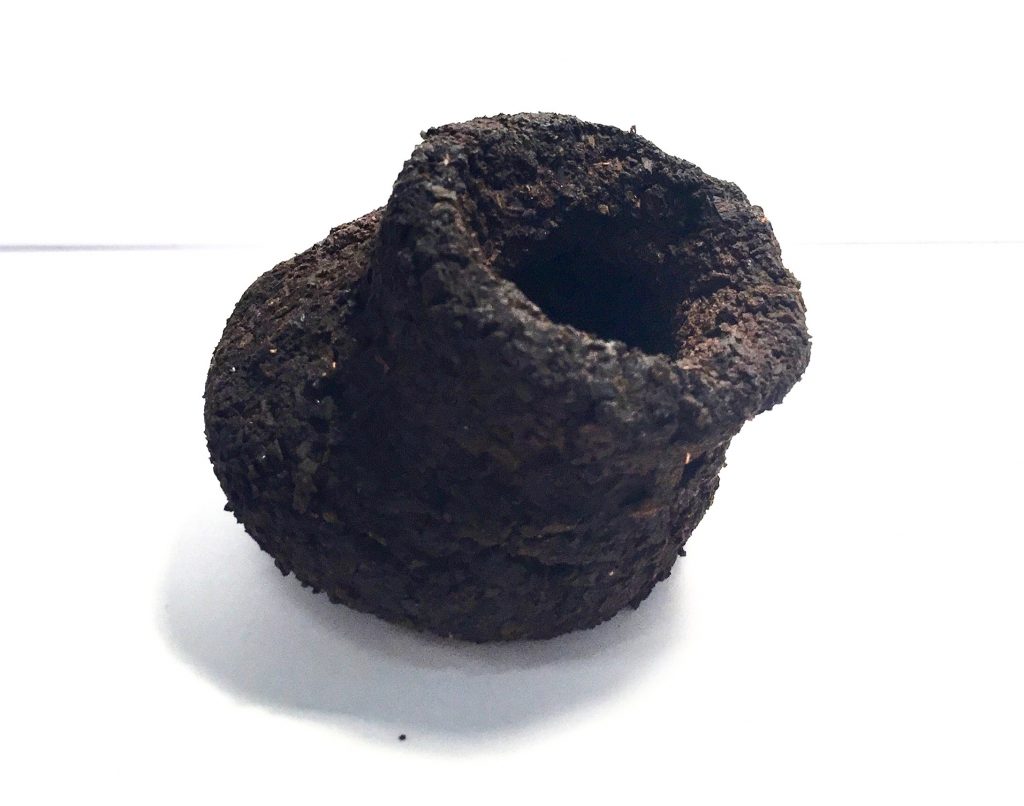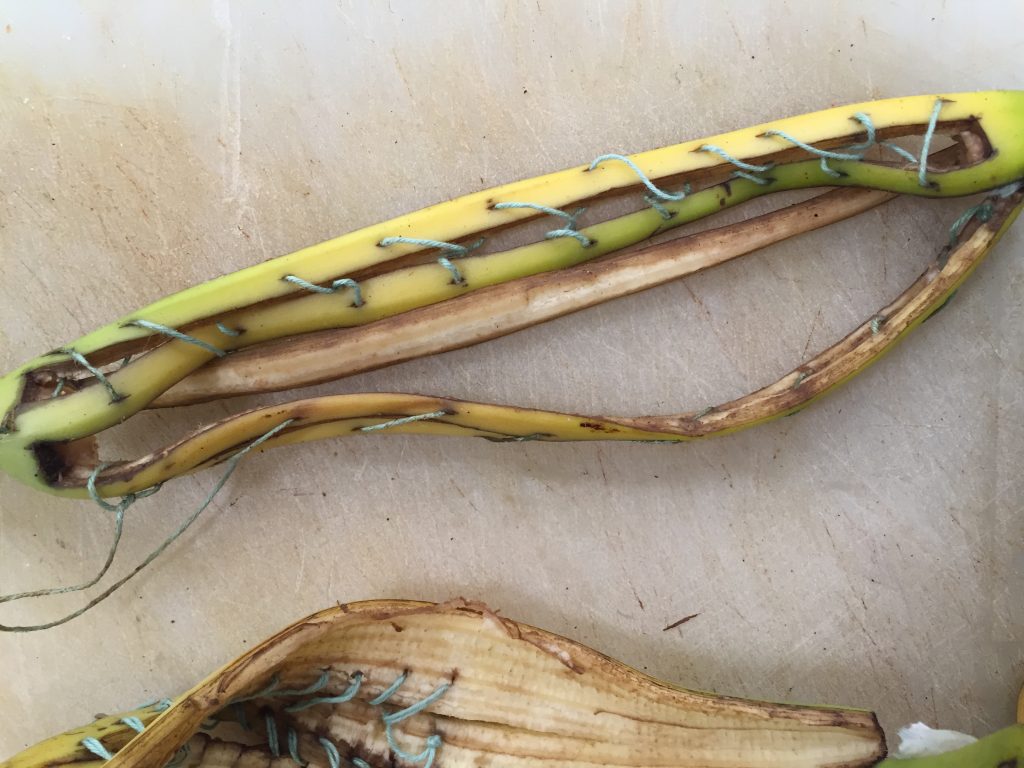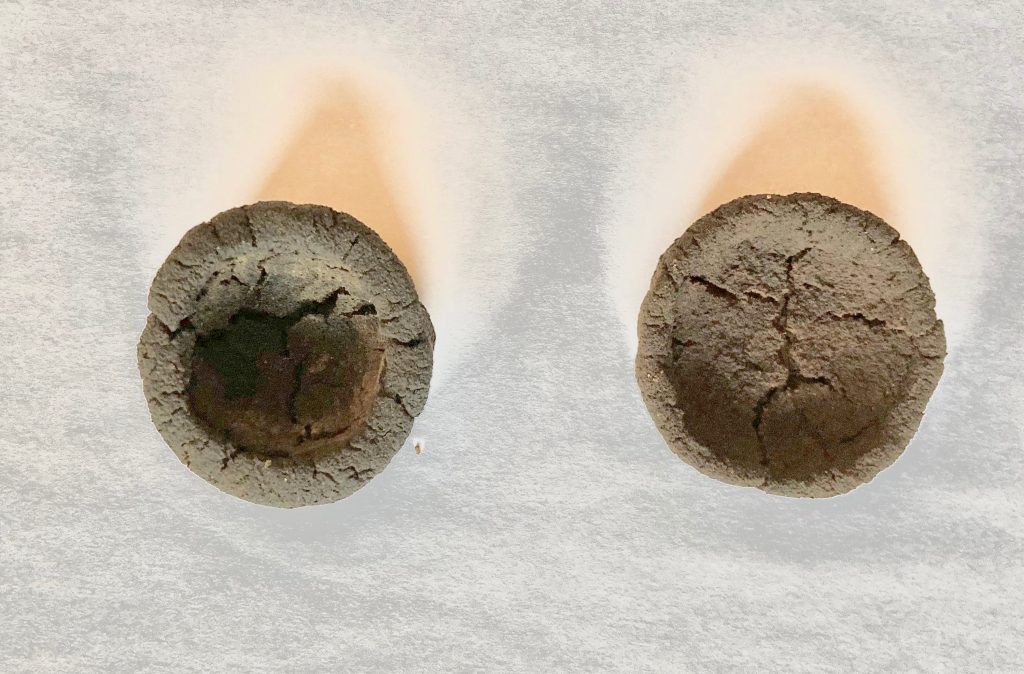Action 9

-Knock knock…
– Whose there?
-Banana
-Banana who?
-Knock knock…
-Whose there?
-Banana
-Banana who?
-Knock knock
-Whose there?
-Banana
– Banana who?
-Knock knock
-Whose there?
-Orange
-Orange who?
-Orange you glad I didn’t say Banana?
Bananas are loaded with cultural meaning. They are also very tactile and stinky; they are materially evocative.
In the action for this week, four of us came together to talk banana. Each of us interacted with bananas through a different material relationship. We sewed banana peels, smooshed banana, ground up dehydrated banana peels and sculpted with a strange banana material. We got our hands dirty while talking about our relationship to this fruit.
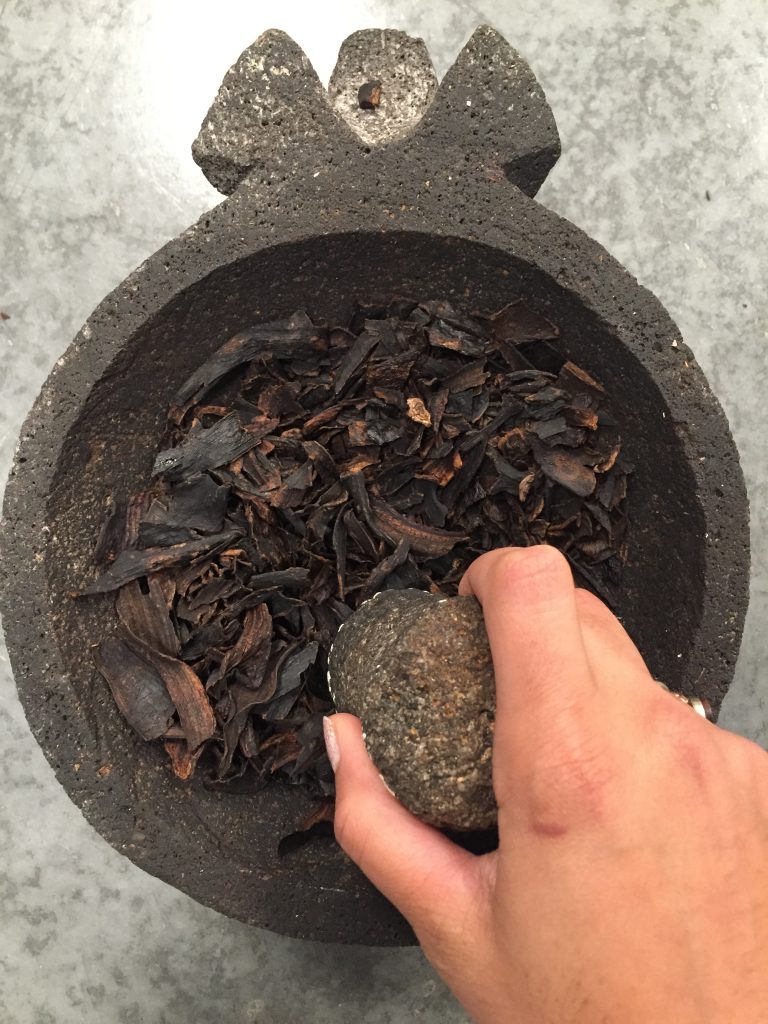

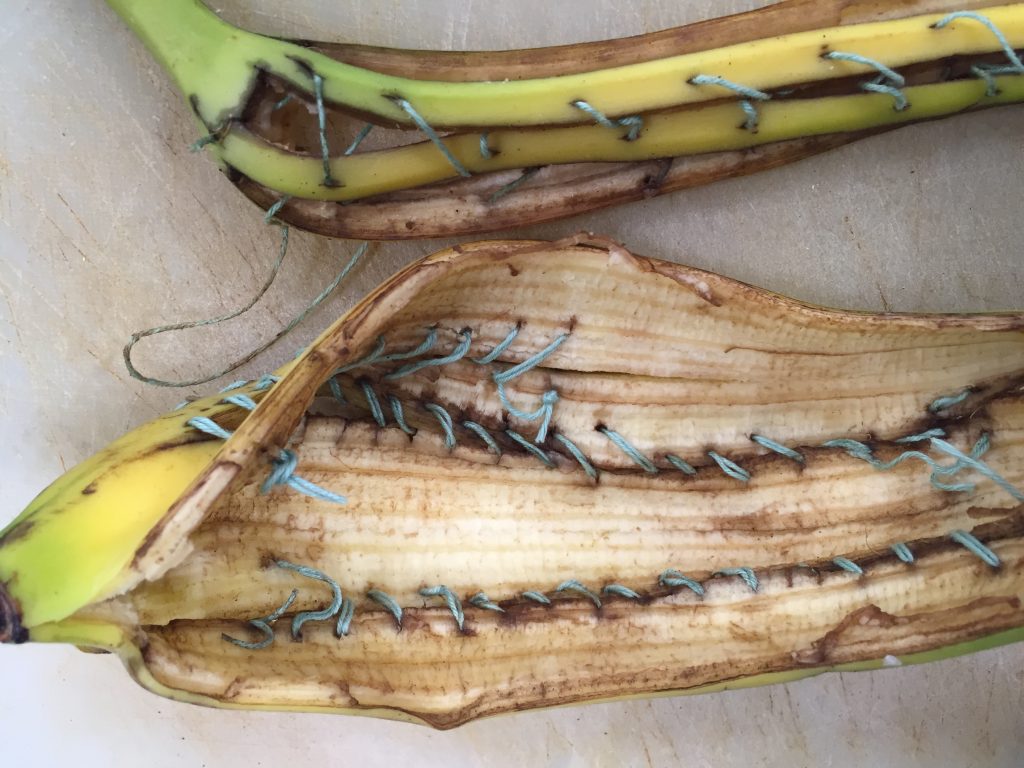
I spent the better part of last year exploring bio-based and organic materials to understand their property as material alternative to plastics. I feel increasingly uncomfortable exploring new materials without understanding where they come from, their material, social, cultural and economic implications. In this action, I explore how systemic considerations can be made central to material exploration and innovation. I am curious about how material exploration can be a co-creative process whereby dialogue and knowledge making about systems implicated in the process of material exploration can be fostered in collaboration with a public.
I spent sometime last semester exploring banana from a very material based perspective. The inquiry was pretty superficial to be honest and didnt touch on geopolitics and socio-economic implications of bananas. I felt it a missed opportunity as banana’s are so loaded with meaning. So I decided to revisit that exploration and facilitate this discussion.
During the mini workshop, we interacted with the banana materials in our own designated way. Sensory aspects of the interaction became instantly obvious. The sound of the smashing mortar and pestle when grinding and the clanking of the spoon against a ribbed bowl while smooshing set the soundtrack for the workshop. Sometime one would stop their action to say something. Sometimes, they would be deeply immersed in their task, articulating a stream of consciousness sort thought process.
crushing, pounding, smashing, grinding
rolling, sculpting, compressing, – “this is so disgusting…Garima!”
sewing, piercing, pulling, mending
“age appropriateness”
The banana material was very evocative as well from the fibrousness of the peels when sewing or the goopy goeeyness of the smooshed banana in the bowl and the crumbly crustiness of the sculpting material. It was certainly a multi-sensory experience.
The following key points came out from the 45 mins discussion:
Changing shopping habits during COVID:: COVID made Melanie bring back pineapples and bananas in her diet. Prior to Covid she hadn’t had many, since she had travelled from the Phillipines. She says “when COVID hit, we would get to three weeks worth of food, and then stay bunkered down, and then go and get two three weeks worth of food. So it was just a totally different shopping cycle. And so things like bananas and pineapples, suddenly we’re back on the list again, because they did well.”
Sexualization of a fruit- asserting control:: While sewing the banana, “I feel like Im frankensteining. I feel like im defiling the banana a little bit. Its interesting thinking about the banana in terms of cultural, or at least Western cultural contexts of life. Sort of something seen as sexual. Like, how can a fruit be sexualized?”
This led to conversations about how food access, food rituals and rhetoric around certain types of food have been historically instrumentalized to control people’s behaviour and personal and cultural freedoms.
Racialized food culture: We talked about how the origins of banana as a comical fruit likely came from vaudeville and was built on racial stereotypes
Who eats bananas- socio-economic status: We were reminiscing about eating bananas in south east asia bought from street vendors. “Banana’s are like peasont fruit no…You’re walking around, and you see some dude with a basket of bananas on his head and you’re like, Hey, here’s a couple of coins for a banana and then you walk around while you’re eating it as if it not supposed to be eaten at home. Some bougie person is not going to, like the Queen of England is not going to open her own banana peel and scarf down a banana sitting at her fancy dining table? No way.”
The value in making together: “Yeah, I’m missing play. I’ve been looking forward to this ever since you suggested because I like making with people. Like, also making for the sake of making without forced or imply that outcomes? I think there is sort of value in the work like, work for work sake. Not because you need to work because you need to work. But like I’m working because the work fulfills me… I feel like so many of the projects, both within the school, but also in the public and business sectors where you have to evaluate everything, you have to have outcomes and like metrics, and everything needs to show measure of success. And so you have to come in with a goal already set. And it’s really hard to come up with legitimacy to discovering your goals and your methods and your metrics through the process.”
Making Verbs
At the end of the discussion, I asked the group to use verbs to describe how they felt interacting with the banananas. Here’s the list
Pressing, pinching, equillibriuming, equalizing, compressing, shaping
Mending, frankesnteining, dirtying (not pejorative), soft, crunchy hard,
Meditating, ritualizing, reconstituting, ephemeralizing
Complicating, actualizing
Post workshop explorations
I went back from the workshop and first downloaded KylaWazana Tomkins book, Racial Indigestion which is a book about the socio-political implications and the racialized history of food. Foods in general but certain type of food is loaded with meaning and the rhetoric around food and sustainability tends to perpetuate racist and neo-liberal structures of choice and individualism. This is my winter break read.
I also went back and did some more banana material exploration. In the workshop Nick reminded me of the Maillard Reaction that takes place during caremalization of foods with lots of sugar. I went back home and found some information about changing the PH of a substance that can hasten this reaction. I set out to incorporate baking soda in my banana recipe. This time the banana peel grounds were much finer, which I used to sculpt little vessel. The PH change actually made the vessels crack even more. To try next:
- baking soda or lye for the exterior of the vessel only. Not to be incorporated in the base material
- Add casien in this recipe for the next iteration.
I do love this material for its smells, its tactility and the physical and chemical properties, not to mention the incredibly loaded fruit it is derived from. It lends well to dialogue and speculation.

Banana Clay
